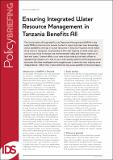| dc.contributor.author | Van Koppen, B | |
| dc.contributor.author | Tarimo, A | |
| dc.coverage.spatial | Tanzania | en_GB |
| dc.date.accessioned | 2014-10-20T14:20:44Z | |
| dc.date.available | 2014-10-20T14:20:44Z | |
| dc.date.issued | 2014-10 | |
| dc.identifier.citation | Van Koppen, B. and Tarimo, A. (2014) Ensuring Integrated Water Resource Management in Tanzania Benefits All, IDS Policy Briefing 76, Brighton: IDS | en_GB |
| dc.identifier.other | KN/11005 | |
| dc.identifier.uri | https://opendocs.ids.ac.uk/opendocs/handle/20.500.12413/4827 | |
| dc.description.abstract | The introduction of Integrated Water Resources Management (IWRM) in the
early 1990s by international donors has led to some important new knowledge
about availability and uses of water resources in Tanzania. However, more needs
to be done to recognise the priorities of the rural majority of small-scale users,
and not just those of donors, the environmental lobby and foreign investors in
land and water. Greater efforts also need to be made by the basin offices to
regulate high-impact users, and to work with existing district and local government
structures that have developed and managed water to serve the rural majority since
independence, rather than create additional top-down parallel institutional layers. | en_GB |
| dc.description.sponsorship | Norwegian Research Council | en_GB |
| dc.language.iso | en | en_GB |
| dc.publisher | IDS | en_GB |
| dc.relation.ispartofseries | IDS Policy Briefing;76 | |
| dc.rights.uri | http://www.ids.ac.uk/files/dmfile/IDSOpenDocsStandardTermsOfUse.pdf | en_GB |
| dc.subject | Water | en_GB |
| dc.title | Ensuring Integrated Water Resource Management in Tanzania Benefits All | en_GB |
| dc.type | IDS Policy Briefing | en_GB |
| dc.rights.holder | IDS | en_GB |

